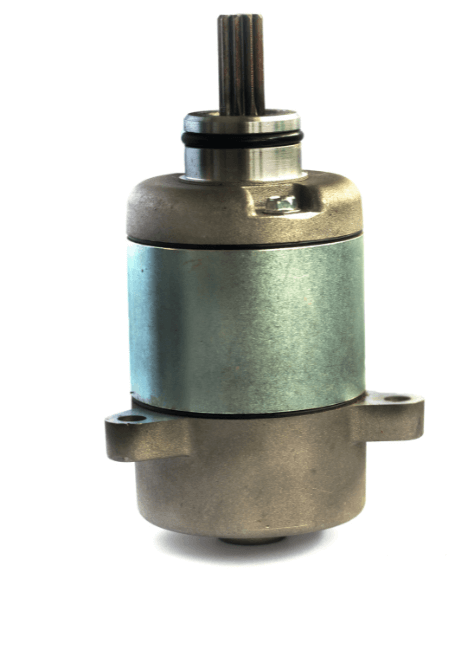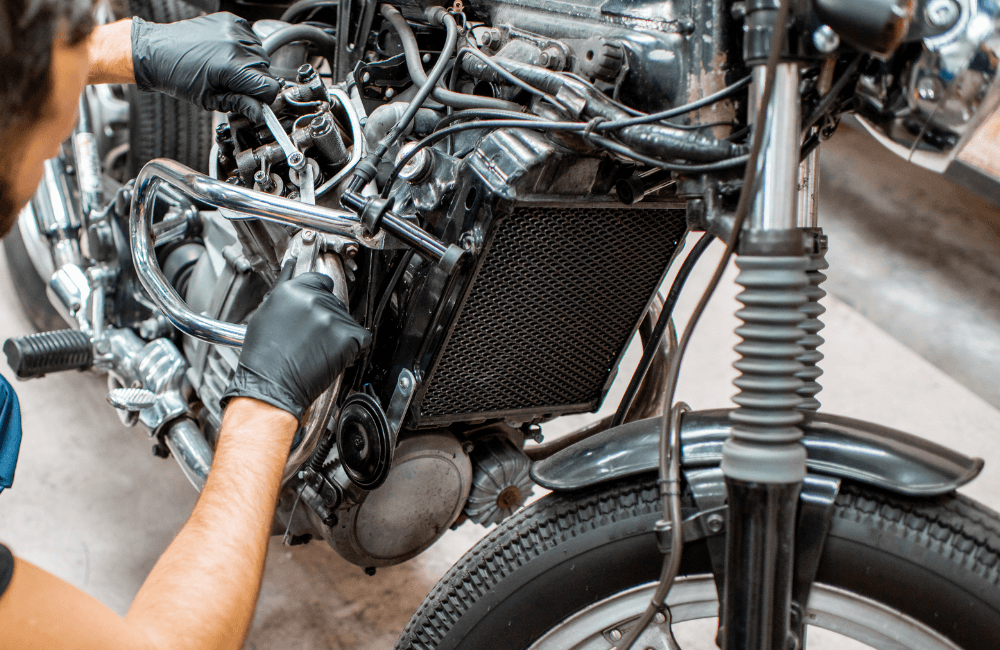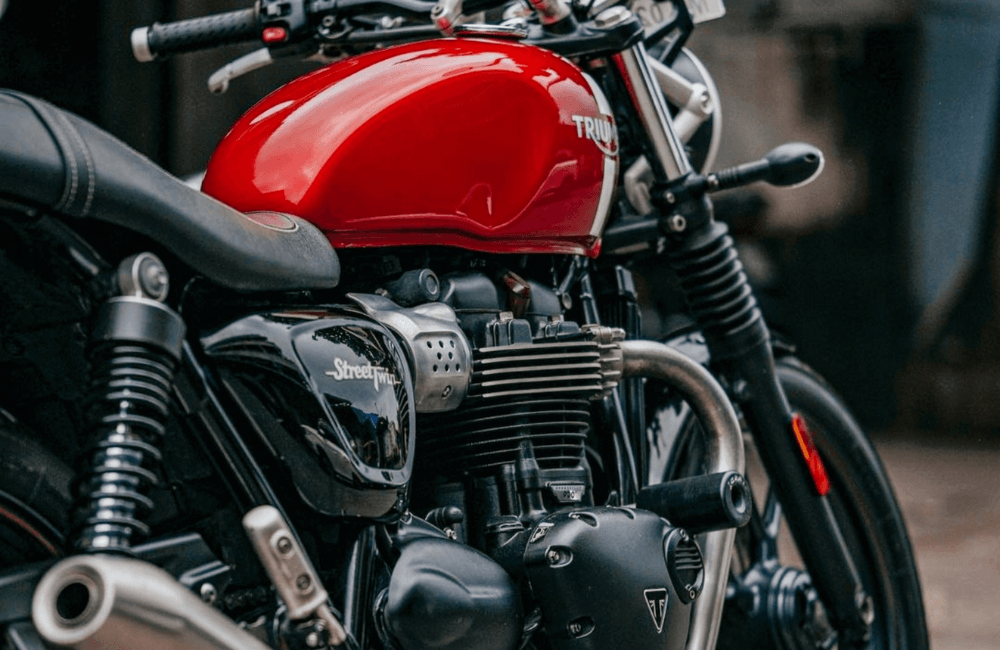It’s what every bike owner dreads—troubleshooting the starter motor. Nothing is more deflating than getting ready for a ride, sticking the key in your bike, thumbing the starter, and it cranks, but the bike won’t start, or it doesn’t even turn over, and the lights are dead.
In this guide, we’ll be covering how a motorcycle starter motor works, how to test a motorcycle starter motor, and most importantly—how to troubleshoot any problems. Hopefully, in most cases, any difficulties with a motor are an easy DIY fix, but in some cases, they may need professional repair work.
When troubleshooting your motorcycle, it’s important to remember the three essential things a motorcycle engine requires: compression, fuel, and spark. These three components are the best places to start if you’ve got starter motor issues.
How Does A Motorcycle Starter Motor Work?

Every motorcycle has a starter motor, which is close to being the bike’s ‘beating heart’; it gets everything else running. A combustion engine must keep rotating to keep running because the energy from one engine cycle is used to initiate the next cycle.
This is where the starter motor comes in. The starter motor’s job is to physically turn the engine so that it can suck in air and fuel to get the cycle started to eventually ride. The engine can’t power itself without the help of a starter motor to start the first ignition and provide energy for the first cycle.
A motorcycle starter motor is similar to starter motors in other vehicles but more compact. Here’s a step-by-step breakdown of the process:
- The starter motor is powered by the battery within the motorcycle. The battery provides the required electrical energy to turn over the engine.
- When you start the motorcycle, for example, the start button (this will depend on the make/model) sends an electrical signal to the starter solenoid.
- The starter solenoid works as a relay switch that activates the high current to operate the starter motor, acting as a bridge between the battery and the starter motor.
- When the solenoid receives the signal, it engages the starter motor and allows the battery’s current to flow directly to the starter motor.
- The starter motor is an electrical motor designed for high torque at low speeds. It will engage with the motorcycle’s engine via a gear known as a starter clutch.
- As the starter motor begins to rotate, it rotates the engine’s internal components with it, like the crankshaft and initiates the internal combustion process so the engine can run on its own.
- Once the engine starts and you release the starter button (or, in some models, it does it automatically), the starter motor will disengage from the engine.
The key components of a starter motor are the battery, the starter solenoid, and the starter motor itself. Each component works together to get your bike’s main engine running.
It’s important to note that not all motorcycles will have a start button. Older models typically tend to have a kickstarter instead, but it functions on the same principles.
Troubleshooting Motorcycle Starter Motor Problems

The process of troubleshooting a motorcycle’s starter motor will depend on the issues you’re having. Below, we’ve compiled a few common steps you can take to diagnose and fix most general starter motor issues.
Check the battery
The most common problem with starter motors is a drained or weak battery. So, check and ensure the battery is fully charged and in good condition. A weak or dying battery can prevent the starter motor from providing enough power to turn the engine over.
Inspect connections
If the battery isn’t the cause of the starter motor issue, we recommend inspecting all electrical connections on your bike-related to the starter motor. This includes the terminals at the battery and starter solenoid. Loose or corroded connections can cause starter motor issues. If you notice any corroded or loose connections, clean them and ensure they’re tight.
Check grounding
If a motorcycle isn’t properly grounded, it can cause intermittent starting problems or even outright stop the starter motor from receiving the correct levels of power.
Inspect the starter clutch
The starter clutch is the component that connects the starter motor to the motorcycle’s crankshaft or flywheel. If the starter motor doesn’t have any problems spinning but isn’t engaging the engine, it could be a starter clutch issue.
Inspect the starter button and ignition system
It’s possible that a faulty start button or ignition system can cause the starter motor system to not properly engage the engine. We recommend testing the starter button and inspecting the ignition system to ensure all connections are secure and functioning.
Consult the service manual
If you’ve gone through the above steps and still haven’t been able to troubleshoot the exact problem, we recommend referring to the motorcycle’s service manual. It can provide detailed instructions on how to inspect and repair your exact make and model, with diagrams.
How To Repair A Motorcycle Starter Motor

Repairing a motorcycle starter motor requires specialised knowledge and skill. If you don’t have the space and tools required or you don’t feel confident, we recommend getting assistance from a qualified mechanic or service technician.
Motorcycle starter motor problems are typically electrical issues. So, if you’re not experienced, it’s best to get a professional, as they can be potentially dangerous if mishandled or repaired incorrectly.
Repairing a motorcycle starter motor is a bit more complex than diagnosing it for issues. Below, we’ve listed general steps to repair a motorcycle starter motor, the tools needed, and safety precautions.
Safety precautions
When working with a starter motor, as it’s an electrical component, it’s important to disconnect the motorcycle’s battery to prevent accidental electrical shorts. We also recommend ensuring that you have more than enough room in your garage or workshop. Also, if possible, get a second person for support in case an accident occurs.
Diagnose the problem
Using the steps laid out in the troubleshooting section above, diagnose and verify the issue with the starter motor. If the problem is related to, for example, the battery or loose connections, this is a simple fix.
In a scenario like this, all you need to do is recharge the battery or replace it if it’s faulty. If the connections are loose, reconnect them and ensure they are secure. If the problem lies within the starter motor itself, you’ll need to get ready for disassembly.
Disassemble the starter motor
After you’ve taken the necessary safety precautions and unplugged the battery, you can move on to disassembling the starter motor if the issue requires it.
Start by unscrewing any bolts or fasteners securing the starter motor to the engine or frame. Afterwards, you’ll want to carefully detach any electrical connections and note their position for reassembly.
Performing necessary repairs or replacements
Assuming you’ve already diagnosed and verified the problem, the next step after disassembly is repairs. Find the parts or component(s) that are worn out or damaged and replace them.
After this, you’ll want to reassemble the starter motor. This includes reconnecting any unplugged electrical wires and securing the starter motor back onto the motorcycle.
How To Test A Motorcycle Starter Motor

After disassembling the starter motor, fixing the issue and putting it back together, you want to test it to see if it works. Before running a test start, we recommend doing a few final checks.
As part of the final checks, you want to ensure all bolts and screws are tightly secured and check all the electrical connections are in place. Afterwards, you can run a test by attempting to start the motorcycle.
If the starter motor is correctly running without any unusual noises or leaks, it should be repaired. If you’re still having issues, we recommend speaking to a professional to verify the problem and repair it.
Motorcycle Servicing And Repairs At Taverner Motorsports
Our team understands that not everyone has the space for routine servicing or repair work. Not only does it require a sizeable workshop, but also specialised tools and equipment.
At Taverner Motorsports, we have a team of qualified mechanics specialising in repair work—from general repairs to component replacements and when you need help troubleshooting a tricky starter motor.
With over 50 years in the industry, you can trust our mechanics with your bike. Our team prides themselves on customer satisfaction. If you’re having a problem with your engine or just bringing your bike in for a service, you can trust that we’ll provide a thorough assessment and transparent communication from start to finish.
We will keep you informed about the required repairs, the estimated costs, and a timeline for completion. If you need repair work or a service for your motorcycle, contact our team today and request a quote.
